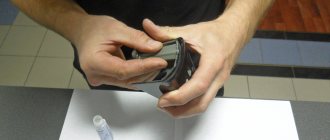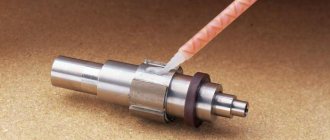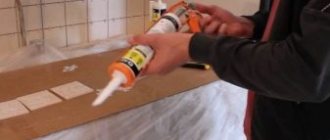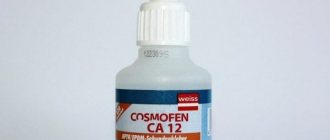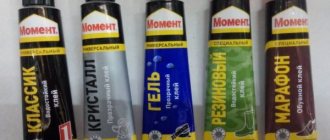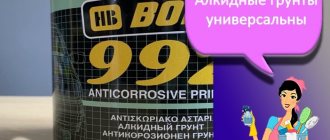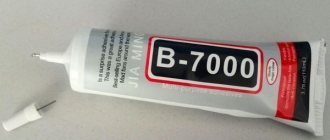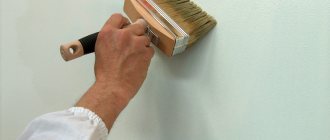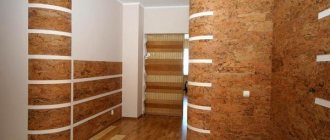What are used as solvents and fillers?
Before using glue, you need to become more familiar with the components from which it is made.
Chlorine compounds
Most rubber mixtures contain chlorine-containing compounds. Manufacturers try to add a minimum amount of such components, as they have a high level of toxicity. Therefore, when choosing an adhesive for further work, you need to familiarize yourself with its composition and make sure that it does not contain many compounds that contain chlorine.
Ethicelate with nefras
Many adhesive liquids are made with the addition of nefras and ethyl acetate. This chemical compound makes the mixture better and increases its adhesion. Therefore, experts recommend using glue that contains petroleum products mixed with acetic acid.
Latex with water content
Latex is added to almost all adhesives. However, in cheap rubber glue this element is not added in its pure form, but along with water. Adding liquid to latex negatively affects the adhesive properties of the product and makes the connection less reliable. Because of this, such applied rubber mixture adheres to the surface much worse.
Resin and polystyrene
Polystyrene with resin is often added to adhesive compositions that are characterized by increased strength. Therefore, in order to glue surfaces more reliably, it is recommended to use just such means. However, you should not buy glue that contains too much polystyrene and resin. A large number of these components negatively affects the elasticity of the connecting seam.
See also
Types and technical characteristics of “Unis” tile adhesive, instructions for use
Sulfur, amines and metal oxides
Companies involved in the production of adhesive mixtures often add metal oxides, amines and sulfur to them. It is thanks to these substances that the vulcanization process occurs, during which plastic rubber turns into rubber. The amount of additives directly depends on how much rubber is contained in the glue.
Consistency stabilizers
Some inexpensive adhesive mixtures turn into a gel over time and adhere less well to the surface. Most often, this problem occurs if the product does not contain consistency stabilizers. These include diethylamine or ethanol. These components maintain the liquid consistency of the glue.
Key Features
This type of glue is often called liquid rubber, because it is made from natural rubber - a natural resin with powerful adhesive abilities. Instead, synthetic resins can be used in the production of the substance. The rubber component to obtain glue is diluted in chemical solutions, depending on the brand and the exact type of product they change. The following may be present in rubber adhesive as solvents and fillers:
- aromatic carbons;
- chlorine-containing compounds;
- ethyl acetate mixed with nefras;
- polystyrene;
- artificial latex;
- resins;
- metal oxides;
- amines;
- sulfur;
- stabilizers – ethanol, diethylamine.
Mineral oils, phthalates, lanolin, and esters of carboxylic acids are added to the composition as plasticizers that improve the properties of the adhesive. In general, each manufacturer develops its own recipe for rubber glue, reducing or increasing the proportion of natural rubber in it and adding new substances. Any product must contain a minimum set of components - a cross-linking agent, a vulcanizing additive and a solvent.
Glue can be used to connect a variety of materials and can be used for household needs, at construction sites, and for repairs. It is used at home to repair bicycle tubes, rubber boats, leather goods, and is used for shoes, filling holes, and defects. This glue can also be used to fix linoleum, carpet, and other floor coverings. Some types are even suitable for working on glass, tiles, and metal. Compositions for industrial use are used to coat table tennis rackets, textiles (for example, gloves), vacuum products, in the production of furniture, and auto parts.
After hardening, the glue in appearance and properties becomes very similar to rubber. The product can be transparent or opaque, which must be taken into account before purchasing. It remains elastic even as it hardens, for which it is valued by craftsmen. Rubber adhesives also have disadvantages:
- the glue seam is not very aesthetically pleasing;
- unpleasant odor due to the presence of solvents;
- the need for good ventilation due to toxicity;
- difficulties with application;
- the appearance of burns on the skin due to careless work;
- the risk of damage to instruments after the end of the process or difficulty in washing them.
Basic properties of rubber glue
Adhesive compositions made on the basis of rubber have certain properties that must be familiarized with before using them:
- Water resistance. Rubber cement is resistant to high humidity and is therefore often used to repair boats, shoes and even wetsuits.
- Strength. This is a highly durable product that is resistant to aggressive conditions.
- Fast drying speed. The applied glue hardens completely within 24 hours.
Varieties and their features
There are six main types of rubber glue, each of which has its own distinctive features.
Natural rubber
Expensive adhesive compositions are made on the basis of natural rubber. They are a white, highly viscous solution used to bond most materials. The hardening process of such mixtures is carried out thanks to the solvents in the composition and the evaporation of excess liquid.
Mixtures made from natural rubber are considered universal, as they are suitable for working with smooth and porous coatings.
Chlorprene
Some people use adhesives made from synthetic rubber rather than natural rubber. Particularly popular are products in the manufacture of which chloroprene microelements were used. Calcium, silicate, silicon dioxide and clay are used as additional additives to such rubber.
Made from nitrile butadiene rubber
Adhesive mixtures, in the manufacture of which nitrile butadiene rubber is used, are free from most of the disadvantages of chloroprene liquids. Experts advise using this glue to join materials made from polyvinyl chloride. The advantages of this glue include its high level of strength, resistance to temperature changes and high humidity.
With silicone rubber
The adhesive mixture is made using sulfur and piperonyl butoxide, which are necessary for vulcanization. Also, thanks to these components, the applied mixture is resistant to moisture and low temperatures.
Use adhesive liquids with silicone rubber to glue rubber surfaces, plastic and glass.
Synthetic styrene butadiene
These viscous fluids are made from styrene butadiene rubbers that are mixed with gasoline and hydrocarbons. Some formulations are also mixed with plasticizers, which are used to increase adhesion and adhesion to surfaces. Most often, styrene glue is used in the furniture industry or for repairing tires.
See also
Technical characteristics of glue sticks, which one is better and how to make it at home
Two-component polyurethane
Two-component products are made from hardeners and polyester-type compounds. The peculiarity of such adhesive liquids is that they dry quickly. Complete hardening occurs half an hour after applying the glue to the surface. Other advantages include water resistance and resistance to temperature changes.
How to choose an adhesive composition
You need to select rubber glue based on the following conditions:
- thickness and size of rubber, its susceptibility to abrasion;
- plasticity or rigidity of the bonded material;
- humidity and temperature conditions;
- external qualities of the finished product;
- chemical composition of glue.
When the requirements and wishes for the resulting adhesive joint are met, the work will be completed efficiently.
Rubber glue is a universal means of repairing various products. With it, you can easily restore the integrity of damaged items at home, and they will last for a long time.
Review of popular brands
There are eleven popular manufacturers of rubber mixtures, whose products are most often used.
Rubber Cement
This is a high-quality composition that is made from natural rubber mixed with solvents. Rubber Cement is most often used to glue elastic products. After drying, the adhesive layer has a rubber-like consistency.
It is resistant to high temperatures and does not lose elasticity in conditions of high humidity.
4508
People who are interested in waterproof products should pay attention to 4508. It is used in the manufacture of products made from rubber. 4508 does not lose its properties when in contact with water and therefore can be used when repairing wetsuits or rubber fishing boats. Among the disadvantages of the product is that it ignites quickly if it is near a fire.
88CA
This is a universal adhesive that is used for gluing metal, wood, glass, concrete, fabric and plastic surfaces. 88 CA is resistant to temperature changes, so it can be used at temperatures from minus fifty to plus sixty degrees. 88 CA must be stored in dark rooms protected from children.
Loctite
This is a one-component adhesive mixture that begins to harden only at room temperature. Therefore, experts recommend using Loctite only indoors. The product is suitable for gluing wooden, metal, plastic and rubber surfaces. The advantage of Loctite is that it hardens within 10-15 seconds after use.
"Gum"
Fans of elastic products should pay attention to “Gummi”. It is used in the repair and manufacture of products made of durable fabric or rubber. Gummi is also suitable for gluing cardboard, paper, wood and genuine leather. Among the advantages of the glue are resistance to low temperatures and high humidity.
"Radical"
People who are going to repair a wetsuit should use the Radical product. It is ideal for restoring water accessories as it is highly resistant to moisture.
Radical can be used for gluing ceramic, concrete, fabric, plastic, metal and wood products.
"Mark A"
This product is used in the manufacture of rubber or leather shoes, bicycle tubes and tires. “Mark A” contains components that exhibit increased adhesion to glass, leather, wood, rubber, paper and foam rubber. Resistant to low temperatures and high air humidity. Thanks to this, it is used both indoors and outdoors.
See also
How and with what can you seal a frame pool at home?
88n
This is a yellowish homogeneous mass, in which there are no foreign inclusions or lumps. 88n is recommended for bonding materials such as plastic, leather, rubber, wood, ceramics, glass, porcelain and paper. The mixture hardens within ten hours after application. During long-term storage, a slight sediment may appear in the liquid, but this does not in any way affect the properties of the adhesive.
GOST 2199-78
According to GOST, adhesive compositions made from natural or synthetic rubber can be used in several fields of activity. They are used during the production of leather furniture or shoes. Glue is also often used to make rubber products that are often in contact with water.
Plasti Dip
This product is made on the basis of an aqueous emulsion containing bitumen-type polymers. Plasti Dip is used for gluing thin rubber materials, paper or wood. The composition is durable and has shock-absorbing properties.
Rubber cement
Rubber cement is often used to restore rubber products. It is often used to repair punctured inflatable boats, bicycle inner tubes or mattresses. The advantages of Rubber cement include rapid hardening, reliability and resistance to moisture.
Types of glue for rubber
Depending on the characteristics of the raw materials, adhesives are divided into the following types:
- based on natural rubber - an ideal quick-drying adhesive for leather, as well as various fabrics, cardboard, paper;
- based on chloroprene - recommended for connecting rubber to wood, glass, plastic;
- Nitrile butadiene is an excellent waterproof adhesive for rubber;
- organosilicon - tetrabutoxylan is required as a hardener, it is used only to bond surfaces made of homogeneous rubber;
- synthetic styrene butadiene - industrial version, not used in everyday life;
- Two-component polyurethane glue is the main product in the shoe industry.
High-quality waterproof rubber adhesive can be in contact with moisture for a long time without losing the strength of the connection and the plasticity of the seam.
Rubber adhesives grade 88
Brand 88 includes a whole range of varieties. These include:
- 88-CA is widely used for the production and repair of shoes;
- 88-NP – for low and high temperatures;
- 88-Lux – universal, widely used in the production of furniture and household appliances;
- 88-N – for connecting vulcanizing rubber to a wide range of different materials, including glass; requires dilution with benzene;
- 88-NT – capable of bonding a wide variety of materials;
- 88-M – increased tear resistance;
- 88-Metal – super-strongly holds metals together;
- 88-KR – is especially often used in the automotive industry.
The universal properties of the brand are given by the composition of nairite, phenol-formaldehyde resin, nefras and a number of other substances. All subspecies of the 88th series are heat-resistant and frost-resistant. Rubber is firmly bonded to a huge number of materials, including cement, concrete, metals and even glass.
This brand is considered one of the best adhesives for rubber.
Due to its powerful adhesive properties, the 88 line is widely used in professional environments: in construction, automotive and other industries.
Rubber Cement
The strength characteristics of this product are somewhat lower than those of others. Nevertheless, when the question arises of what kind of glue to glue shoes with, it is most often chosen.
The surfaces to be joined must be carefully prepared and cleaned of grease and dirt. Irregularities do not affect the quality of the solder joint.
Rubber Cement hardens quickly. The resulting seam has properties identical to rubber and is not afraid of high humidity.
Loctite
This cyanoacrylate product answers the question of how to quickly glue rubber. With its help, the connection can be made almost instantly. Ideal for large repairs and small joints. Polymerization occurs almost immediately after application to the surface. The parts must be pressed tightly against each other.
The connections can withstand high tensile and shear loads.
Loctite has maximum adhesion to plastic. It holds fiberglass together well, but cannot bond glass. When working with a number of substances, it requires the use of special primers that improve adhesion.
Rubber glue 4508
High-quality elastic rubber adhesive is recognized as one of the best superglues. Suitable even for the manufacture and repair of watercraft and fishing clothing. With its help, you can seal the rubber and install a patch with maximum reliability.
The seams are moisture-resistant, elastic, and do not allow water to pass through.
The hardened adhesive layer has the following properties:
- increased water resistance;
- good resistance to stretching and vibration;
- the seam does not lose strength at temperatures up to +50°C.
Before application, the surface must be thoroughly degreased.
Viscosity can be changed depending on the task. Nefras is something that can be used to dilute rubber glue of this brand.
Rubber moment
This rubber glue is one of the best. It is suitable for any type of rolled rubber coating, including foam. The soldering turns out almost perfect. The strength of the connection is maintained at high temperatures up to +100°C.
This rubber glue dries even with the lid tightly closed. Therefore, if the tube has been opened, then soon all its contents will harden.
Rubber “Moment” must be kept away from fire, as the substance is flammable.
Adhesive rubber mastic KN-2
The base is synthetic rubber. The mastic is intended for construction, repair and finishing work. Widely used to fasten flooring, roofing materials, wall panels, drywall, waterproofing materials.
The frozen mastic acquires the properties of rubber. The color of the seam is black or yellow-brown.
When the question arises of how to glue parquet or bitumen shingles, you can safely opt for KN-2 mastic. This substance:
- has good adhesion;
- suppresses the development of mold;
- does not attract insects;
- tolerates moisture well;
- actively fills cracks and cracks.
The fastening is very strong, but quite elastic.
Rubber adhesive grade A
This is a good quick-drying glue for rubber, so it is used for sealing car tire tubes, repairing household items, and creating various crafts. In addition, it is a powerful sealant. Can be applied to the surface without prior degreasing.
Rubber glue grade A easily forms a neat, elastic seam.
Resistant to moisture, oil- and gasoline-containing substances.
Radical
Durable and multi-functional repair adhesive. Can be used in the repair of boat equipment, fins, wetsuits, and any floating structures and equipment. The color is usually black.
Radical has powerful adhesion to various substances.
The hardened joint is able to withstand high pressure, exposure to fresh and salt water, and retains its properties in the temperature range from –40 to +70°C.
Kernil
A cyanoacrylate substance that provides a powerful compound. It sets very quickly and hardens instantly. Due to its excellent adhesion to a wide variety of substances, it is used in the following cases:
- connection of boards;
- production of electrical parts;
- production of plastic products;
- gluing fabrics, leather, foam rubber.
Kernil has an important property: it does not change the color of the surfaces being bonded.
Other types
The number of types of rubber adhesives is very large, and each type has its own characteristics. For example:
- seams made with KR-5-18 glue do not dissolve even with prolonged exposure to petroleum products;
- SinTex MF red is specifically aimed at furniture production;
- epoxy adhesives have a wide range of applications, from simple household tasks to aircraft construction;
- transparent superglue IRFIX Super Glue 502 is resistant to ultraviolet rays, therefore it is ideal for EPDM-based materials used in fastening display cases, windows, and facade finishing.
Silicone rubber-based products are excellent at bonding ceramics, glass and other complex materials, but they can cause corrosion on ferrous metals.
Rules and features of application
There are two main ways to use adhesive mixtures.
Hot gluing
To more securely fix materials, people use the hot gluing method. In this case, the composition is preheated with a construction hairdryer. Only after heating is it applied to the surface to be glued.
Cold gluing
When gluing cold, the composition does not need to be preheated. It is applied to the coating in its original form. However, before this, the surface must be prepared. It is cleaned of debris, traces of dirt and degreased. When gluing cold, the adhesive layer dries in about 8-10 hours.
